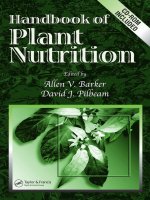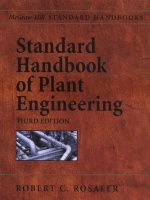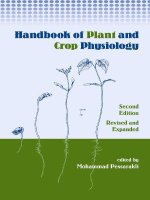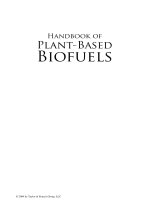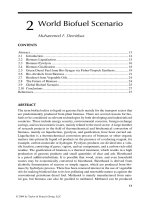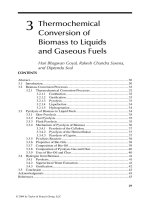handbook of plant & crop physiology revised & expanded - mohammad pessarakli
Bạn đang xem bản rút gọn của tài liệu. Xem và tải ngay bản đầy đủ của tài liệu tại đây (8.54 MB, 997 trang )
TM
Marcel Dekker, Inc. New York
•
Basel
Handbook of Plant and
Crop Physiology
Second Edition
Revised and Expanded
edited by
Mohammad Pessarakli
The University of Arizona
Tucson, Arizona
Copyright © 2001 by Marcel Dekker, Inc. All Rights Reserved.
ISBN: 0-8247-0546-7
This book is printed on acid-free paper.
Headquarters
Marcel Dekker, Inc.
270 Madison Avenue, New York, NY 10016
tel: 212-696-9000; fax: 212-685-4540
Eastern Hemisphere Distribution
Marcel Dekker AG
Hutgasse 4, Postfach 812, CH-4001 Basel, Switzerland
tel: 41-61-261-8482; fax: 41-61-261-8896
World Wide Web
The publisher offers discounts on this book when ordered in bulk quantities. For more in-
formation, write to Special Sales/Professional Marketing at the headquarters address
above.
Copyright © 2002 by Marcel Dekker, Inc. All Rights Reserved.
Neither this book nor any part may be reproduced or transmitted in any form or by any
means, electronic or mechanical, including photocopying, microfilming, and recording, or
by any information storage and retrieval system, without permission in writing from the
publisher.
Current printing (last digit):
10987654321
PRINTED IN THE UNITED STATES OF AMERICA
BOOKS IN SOILS, PLANTS, AND THE ENVIRONMENT
Editorial Board
Agricultural Engineering Robert M. Peart, University of Florida, Gainesville
Animal Science Harold Hafs, Rutgers University, New Brunswick, New Jersey
Crops Mohammad Pessarakli, University of Arizona, Tucson
Irrigation and Hydrology Donald R. Nielsen, University of California, Davis
Microbiology Jan Dirk van Elsas, Research Institute for Plant Protection,
Wageningen, The Netherlands
Plants L. David Kuykendall, U.S. Department of Agriculture, Belts-
ville, Maryland
Kenneth B. Marcum, Texas A&M University, El Paso, Texas
Soils Jean-Marc Bollag, Pennsylvania State University, University
Park, Pennsylvania
Tsuyoshi Miyazaki, University of Tokyo
Soil Biochemistry, Volume 1, edited by A. D. McLaren and G. H. Peterson
Soil Biochemistry, Volume 2, edited by A. D. McLaren and J. Skujiòð
Soil Biochemistry, Volume 3, edited by E. A. Paul and A. D. McLaren
Soil Biochemistry, Volume 4, edited by E. A. Paul and A. D. McLaren
Soil Biochemistry, Volume 5, edited by E. A. Paul and J. N. Ladd
Soil Biochemistry, Volume 6, edited by Jean-Marc Bollag and G. Stotzky
Soil Biochemistry, Volume 7, edited by G. Stotzky and Jean-Marc Bollag
Soil Biochemistry, Volume 8, edited by Jean-Marc Bollag and G. Stotzky
Soil Biochemistry, Volume 9, edited by G. Stotzky and Jean-Marc Bollag
Organic Chemicals in the Soil Environment, Volumes 1 and 2, edited by C. A. I.
Goring and J. W. Hamaker
Humic Substances in the Environment, M. Schnitzer and S. U. Khan
Microbial Life in the Soil: An Introduction, T. Hattori
Principles of Soil Chemistry, Kim H. Tan
Soil Analysis: Instrumental Techniques and Related Procedures, edited by Keith A.
Smith
Soil Reclamation Processes: Microbiological Analyses and Applications, edited by
Robert L. Tate III and Donald A. Klein
Symbiotic Nitrogen Fixation Technology, edited by Gerald H. Elkan
Soil–Water Interactions: Mechanisms and Applications, Shingo Iwata and Toshio
Tabuchi with Benno P. Warkentin
Soil Analysis: Modern Instrumental Techniques, Second Edition, edited by Keith A.
Smith
Soil Analysis: Physical Methods, edited by Keith A. Smith and Chris E. Mullins
Growth and Mineral Nutrition of Field Crops, N. K. Fageria, V. C. Baligar, and Charles
Allan Jones
Semiarid Lands and Deserts: Soil Resource and Reclamation, edited by J. Skujiòð
Plant Roots: The Hidden Half, edited by Yoav Waisel, Amram Eshel, and Uzi Kafkafi
Plant Biochemical Regulators, edited by Harold W. Gausman
Maximizing Crop Yields, N. K. Fageria
Transgenic Plants: Fundamentals and Applications, edited by Andrew Hiatt
Soil Microbial Ecology: Applications in Agricultural and Environmental Management,
edited by F. Blaine Metting, Jr.
Principles of Soil Chemistry: Second Edition, Kim H. Tan
Water Flow in Soils, edited by Tsuyoshi Miyazaki
Handbook of Plant and Crop Stress, edited by Mohammad Pessarakli
Genetic Improvement of Field Crops, edited by Gustavo A. Slafer
Agricultural Field Experiments: Design and Analysis, Roger G. Petersen
Environmental Soil Science, Kim H. Tan
Mechanisms of Plant Growth and Improved Productivity: Modern Approaches, edited
by Amarjit S. Basra
Selenium in the Environment, edited by W. T. Frankenberger, Jr., and Sally Benson
Plant–Environment Interactions, edited by Robert E. Wilkinson
Handbook of Plant and Crop Physiology, edited by Mohammad Pessarakli
Handbook of Phytoalexin Metabolism and Action, edited by M. Daniel and R. P.
Purkayastha
Soil–Water Interactions: Mechanisms and Applications, Second Edition, Revised and
Expanded, Shingo Iwata, Toshio Tabuchi, and Benno P. Warkentin
Stored-Grain Ecosystems, edited by Digvir S. Jayas, Noel D. G. White, and William
E. Muir
Agrochemicals from Natural Products, edited by C. R. A. Godfrey
Seed Development and Germination, edited by Jaime Kigel and Gad Galili
Nitrogen Fertilization in the Environment, edited by Peter Edward Bacon
Phytohormones in Soils: Microbial Production and Function, William T. Franken-
berger, Jr., and Muhammad Arshad
Handbook of Weed Management Systems, edited by Albert E. Smith
Soil Sampling, Preparation, and Analysis, Kim H. Tan
Soil Erosion, Conservation, and Rehabilitation, edited by Menachem Agassi
Plant Roots: The Hidden Half, Second Edition, Revised and Expanded, edited by
Yoav Waisel, Amram Eshel, and Uzi Kafkafi
Photoassimilate Distribution in Plants and Crops: Source–Sink Relationships, edited
by Eli Zamski and Arthur A. Schaffer
Mass Spectrometry of Soils, edited by Thomas W. Boutton and Shinichi Yamasaki
Handbook of Photosynthesis, edited by Mohammad Pessarakli
Chemical and Isotopic Groundwater Hydrology: The Applied Approach, Second
Edition, Revised and Expanded, Emanuel Mazor
Fauna in Soil Ecosystems: Recycling Processes, Nutrient Fluxes, and Agricultural
Production, edited by Gero Benckiser
Soil and Plant Analysis in Sustainable Agriculture and Environment, edited by Teresa
Hood and J. Benton Jones, Jr.
Seeds Handbook: Biology, Production, Processing, and Storage: B. B. Desai, P. M.
Kotecha, and D. K. Salunkhe
Modern Soil Microbiology, edited by J. D. van Elsas, J. T. Trevors, and E. M. H.
Wellington
Growth and Mineral Nutrition of Field Crops: Second Edition, N. K. Fageria, V. C.
Baligar, and Charles Allan Jones
Fungal Pathogenesis in Plants and Crops: Molecular Biology and Host Defense
Mechanisms, P. Vidhyasekaran
Plant Pathogen Detection and Disease Diagnosis, P. Narayanasamy
Agricultural Systems Modeling and Simulation, edited by Robert M. Peart and R.
Bruce Curry
Agricultural Biotechnology, edited by Arie Altman
Plant–Microbe Interactions and Biological Control, edited by Greg J. Boland and L.
David Kuykendall
Handbook of Soil Conditioners: Substances That Enhance the Physical Properties of
Soil, edited by Arthur Wallace and Richard E. Terry
Environmental Chemistry of Selenium, edited by William T. Frankenberger, Jr., and
Richard A. Engberg
Principles of Soil Chemistry: Third Edition, Revised and Expanded, Kim H. Tan
Sulfur in the Environment, edited by Douglas G. Maynard
Soil–Machine Interactions: A Finite Element Perspective, edited by Jie Shen and
Radhey Lal Kushwaha
Mycotoxins in Agriculture and Food Safety, edited by Kaushal K. Sinha and Deepak
Bhatnagar
Plant Amino Acids: Biochemistry and Biotechnology, edited by Bijay K. Singh
Handbook of Functional Plant Ecology, edited by Francisco I. Pugnaire and Fernando
Valladares
Handbook of Plant and Crop Stress: Second Edition, Revised and Expanded, edited
by Mohammad Pessarakli
Plant Responses to Environmental Stresses: From Phytohormones to Genome
Reorganization, edited by H. R. Lerner
Handbook of Pest Management, edited by John R. Ruberson
Environmental Soil Science: Second Edition, Revised and Expanded, Kim H. Tan
Microbial Endophytes, edited by Charles W. Bacon and James F. White, Jr.
Plant–Environment Interactions: Second Edition, edited by Robert E. Wilkinson
Microbial Pest Control, Sushil K. Khetan
Soil and Environmental Analysis: Physical Methods, Second Edition, Revised and
Expanded, edited by Keith A. Smith and Chris E. Mullins
The Rhizosphere: Biochemistry and Organic Substances at the Soil–Plant Interface,
Roberto Pinton, Zeno Varanini, and Paolo Nannipieri
Woody Plants and Woody Plant Management: Ecology, Safety, and Environmental
Impact, Rodney W. Bovey
Metals in the Environment, M. N. V. Prasad
Plant Pathogen Detection and Disease Diagnosis: Second Edition, Revised and Ex-
panded, P. Narayanasamy
Handbook of Plant and Crop Physiology: Second Edition, Revised and Expanded,
edited by Mohammad Pessarakli
Environmental Chemistry of Arsenic, edited by William T. Frankenberger, Jr.
Enzymes in the Environment: Activity, Ecology, and Applications, edited by Richard
G. Burns and Richard P. Dick
Plant Roots: The Hidden Half, Third Edition, Revised and Expanded, edited by Yoav
Waisel, Amram Eshel, and Uzi Kafkafi
Handbook of Plant Growth: pH as the Master Variable, edited by Zdenko Rengel
Biological Control of Major Crop Plant Diseases, edited by Samuel S.
Gnanamanickam
Pesticides in Agriculture and the Environment, edited by Willis B. Wheeler
Mathematical Models of Crop Growth and Yield, Allen R. Overman and Richard
Scholtz
Plant Biotechnology and Transgenic Plants, edited by Kirsi-Marja Oksman-Caldentey
and Wolfgang Barz
Handbook of Postharvest Technology: Cereals, Fruits, Vegetables, Tea, and Spices,
edited by Amalendu Chakraverty, Arun S. Mujumdar, G. S. Vijaya Raghavan,
and Hosahalli S. Ramaswamy
Handbook of Soil Acidity, edited by Zdenko Rengel
Additional Volumes in Preparation
Humic Matter: Issues and Controversies in Soil and Environmental Science, Kim H.
Tan
Molecular Host Resistance to Pests, S. Sadasivam and B. Thayumanavan
In the memory of my beloved parents, Fatima and Vahab,
who regretfully did not live to see this work,
which in no small part resulted from their gift of many years of love.
v
Like any other area in science, both the scope and depth of our knowledge of plant and crop physiology
are rapidly expanding. Plant/crop physiologists are continuously making new discoveries. This phe-
nomenon has resulted in the compilation of a large volume of information since the first edition of the
Handbook of Plant and Crop Physiology was prepared and presented to scientists and professionals. The
abundance of new data has necessitated that this unique, comprehensive source of information be revised
to include all the new discoveries in the field. Like the first edition, the new edition of the Handbook of
Plant and Crop Physiology is a unique, comprehensive, and complete collection of the topics in
plant/crop physiology.
More than two-thirds of the material in the new edition is entirely new; these are included under new
titles. The other one-third has been updated and substantially modified. This new edition consists of 12
parts while the first edition consisted of eight. Overall, about 80% of this book is new and a totally new
volume has emerged.
The Handbook of Plant and Crop Physiology is needed to fill the gap in the available literature. In
addition, it has long been recognized that physiological processes control plant growth and crop yields.
Therefore, this handbook is prepared in a single volume to serve as a comprehensive resource and up-to-
date reference to effectively cover the information relevant to plant/crop physiology that is scattered
among plant/crop physiology books as well as plant physiology journals.
Several difficult decisions must be made when one plans to compile a handbook, such as the extent
of content to include, the information to exclude, the depth to which the topics should be covered, and the
organization of the selected content. I have chosen to include information that will be beneficial to stu-
dents, instructors, researchers, field specialists, and any others interested in the areas of plant and crop
physiology. In order to plan, implement, and evaluate comprehensive and specific strategies for dealing
with plant and crop physiology problems, strategies must be based on a firm understanding of the facts
and the principles.
The topics selected for discussion are those that I believe are relevant, and in which physiology plays
the dominant role. The concepts have been presented to allow both beginning students and specialists of
this discipline an opportunity to expand and refine their knowledge. Certain conclusions provided
throughout the text are related to the more significant and multifaceted problems of plant and crop phys-
iology. They are presented to provide a concise guide to the most relevant goals of both the students and
the specialists.
This practical and comprehensive guide has been prepared by 76 contributors from 17 countries,
among the most competent and knowledgeable scientists, specialists, and researchers in agriculture. It is
intended to serve as a resource for both lecture and independent purposes—for scientists, agriculture re-
searchers, agriculture practitioners, and both educators and students in agricultural disciplines.
To facilitate the accessibility of desired information, the volume has been divided into 12 parts. Al-
though the parts are interrelated, each serves independently to facilitate the understanding of the material
presented therein. Each part also enables the reader to acquire confidence in his or her learning and use
of the information offered.
Part I, Plants/Crops Growth Responses to Environmental Factors and Climatic Changes, consists of
three chapters addressing these factors in detail. The seven chapters in Part II, Physiology of Plant/Crop
Growth and Developmental Stages, cover plant physiological stages from seed germination to plant
senescence and abscission. Part III, Cellular and Molecular Aspects of Plant/Crop Physiology, consists of
five chapters that present in-depth information on cellular and molecular aspects of plant/crop organs.
Part IV, Plant/Crop Physiology and Physiological Aspects of Plant/Crop Production Processes, contains
eight chapters that link plant/crop physiology to production of food, feed, and medicinal compounds and
discuss this relationship in detail. The four chapters in Part V, Plant Growth Regulators: The Natural Hor-
mones (Growth Promoters and Inhibitors) and Plant Genes, address growth promoters, and growth in-
hibitor hormones as well as plant genes.
Since plants and crops, like other living things, at one time or another during their life cycle en-
counter biotic or abiotic stressful conditions, two parts [VI, Physiological Responses of Plants/Crops Un-
der Stressful (Salt, Drought, and Other Environmental Stresses) Conditions and VII, Physiological Re-
sponses of Plants/Crops to Heavy Metal Concentration and Agrichemicals] are devoted to the
physiological responses of plants and crops to stress. Several examples of empirical investigations of spe-
cific plants and crops grown under stressful conditions are presented.
The single—but thorough—chapter in Part VIII, Physiological Relationships Between Lower and
Higher Plants, presents detailed information on this relationship.
The physiology of plant genetics is presented in two parts. Physiology of Lower-Plant Genetics and
Development, Part IX, consists of one chapter that discusses developmental genetics in lower plants. Part
X, Physiology of Higher-Plant/Crop Genetics and Development, contains four chapters that comprehen-
sively review this subject. Part XI, Using Computer Modeling in Plant Physiology, consists of one chap-
ter on computer simulation of plant and Crop allocation processes.
Finally, to extend the subject of plant/crop physiology beyond the earth, I included Part XII,
Plant/Crop Physiology under Controlled Conditions, in Space, and on Other Planets. Its two chapters pre-
sent the most recent available information on plant/crop physiology in controlled environment and per-
spectives for human life support on other planets.
Numerous figures, tables, and illustrations are included in this technical guide to facilitate compre-
hension of the presented materials. The index words further increase accessibility to the information.
It is hoped that an individual with a problem in the area of plant/crop physiology will turn to this prac-
tical and professional reference book and be able to promptly acquire the necessary assistance to solve
that problem.
Like other fields, the area of plant/crop physiology has been growing so rapidly that all plant/crop
physiologists are faced with the problem of constantly updating their knowledge. To grow with their pro-
fession, they will need to extend their interests and skills. In this regard, even a casual reading of the ma-
terial in this handbook will help them to move ahead in the right direction.
Mohammad Pessarakli
vi PREFACE
vii
I would like to express my special appreciation for secretarial assistance from Mrs. Elenor R. Loya, De-
partment of Soil, Water and Environmental Science, University of Arizona. Additional assistance by the
secretarial staff of the Department of Plant Sciences, University of Arizona, is also greatly appreciated.
In addition, my sincere gratitude is extended to Mr. Russell Dekker (Chief Publishing Officer, Mar-
cel Dekker, Inc.), who supported this project from its initiation to its completion. Certainly, this job would
not have been completed as smoothly and rapidly without his most valuable support and sincere efforts.
Also, Production Editor Ms. Dana Bigelow’s patience and outstanding efforts in the careful and profes-
sional handling of this volume are greatly appreciated. The precision and accuracy of the copyeditor, Ms.
Mary Prescott, are sincerely acknowledged.
The invaluable efforts of every one of the contributors are deeply appreciated. Their proficiency and
knowledge in their areas of expertise made this significant task possible.
I thank my wife, Vinca, for her support in the completion of this work. Last, but not least, I would
like to express my gratitude to my son, Mahdi, who had great patience and understanding and let me take
time to complete this project that would have otherwise been spent with him.
Acknowledgments
ix
Preface v
Contributors xiii
Part I Plants/Crops Growth Responses to Environmental Factors and Climactic Changes
1 Time, Plant Growth, Respiration, and Temperature 1
Bruce N. Smith, Lyneen C. Harris, V. Wallace McCarlie, Dorothy L. Stradling,
Tonya Thygerson, Jillian Walker, Richard S. Criddle, and Lee D. Hansen
2 Role of Temperature in the Physiology of Crop Plants: Pre- and Postharvest 13
William Grierson
3 Crop Plant Responses to Rising CO
2
and Climate Change 35
Joseph C. V. Vu, Leon Hartwell Allen, Jr., and Maria Gallo-Meagher
Part II Physiology of Plant/Crop Growth and Developmental Stages
4 Germination and Emergence 57
Calvin Chong, Bernard B. Bible, and Hak-Yoon Ju
5 Influence of Source Strength on Leaf Developmental Programming 117
Steven Rodermel, Adam Miller, and Martin Spalding
6 Ecophysiological Aspects of the Vegetative Propagation of Saltbush (Atriplex spp.)
and Mulberry (Morus spp.) 127
David N. Sen and Pramila Rajput
7 Fruit Development, Maturation, and Ripening 143
William Grierson
8 Dormancy: Manifestations and Causes 161
Frank G. Dennis, Jr.
9 Senescence in Plants and Crops 181
Lola Peñarrubia and Joaquín Moreno
10 Abscission 205
Roy Sexton
Part III Cellular and Molecular Aspects of Plant/Crop Physiology
11 Cell Cycle Regulation in Plants 229
A. S. N. Reddy and Irene S. Day
12 Chlorophyll Biosynthesis During Plant Greening 265
Benoît Schoefs
13 Structure and Function of Photosynthetic Membranes in Higher Plants 281
Ilia D. Denev and Ivan N. Minkov
14 Bioenergetic Aspects of Photosynthetic Gas Exchange and Respiratory Processes
in Algae and Plants 299
Klaus Peter Bader and Refat Abdel-Basset
15 Diffusive Resistances to CO
2
Entry in the Leaves and Their Limitations
to Photosynthesis 327
Angelo Massacci and Francesco Loreto
Part IV Plant/Crop Physiology and Physiological Aspects of Plant/Crop Production Processes
16 Mineral Nutrient Transport in Plants 337
Benjamin Jacoby and Nava Moran
17 Sodium: A Functional Nutrient in Plants 363
G. V. Subbarao, Raymond M. Wheeler, Wade L. Berry, and Gary W. Stutte
18 Nitrogen Metabolism and Crop Productivity 385
Fred E. Below
19 Quantifying Immediate Carbon Export from Source Leaves 407
Evangelos Demosthenes Leonardos and Bernard Grodzinski
20 Production-Related Assimilate Transport and Partitioning 421
John E. Hendrix
21 Phloem Transport of Solutes in Crop Plants 449
Edmund R. Miranda, Wattana Pattanagul, and Monica A. Madore
22 Carbohydrate Synthesis and Crop Metabolism 467
Wattana Pattanagul, Edmund R. Miranda, and Monica A. Madore
x CONTENTS
23 Production of Phytomedicinal Chemicals by Plants 485
Donald P. Briskin
Part V Plant Growth Regulators: The Natural Hormones (Growth Promoters and Inhibitors)
and Plant Genes
24 Plant Growth Hormones: Growth Promoters and Inhibitors 501
Syed Shamshad Mehdi Naqvi
25 The Activation Sequence-1 Cognate Promoter Elements Play Critical Roles in the
Activation of Defense-Related Genes in Higher Plants 527
Chengbin Xiang
26 Multilevel Regulation of Glutathione Homeostasis in Higher Plants 539
Chengbin Xiang and David J. Oliver
27 Genes Associated with Orchid Flower 549
Soek Ying Neo and Kwok Ki Ho
Part VI Physiological Responses of Plants/Crops Under Stressful (Salt, Drought, and Other
Environmental Stresses) Conditions
28 Biology and Physiology of Saline Plants 563
David N. Sen, Sher Mohammed, and Pawan K. Kasera
29 Role of Physiology in Improving Crop Adaptation to Abiotic Stresses in the Tropics:
The Case of Common Bean and Tropical Forages 583
Idupulapati Madhusudana Rao
30 Adaptive Components of Salt Tolerance 615
James W. O’Leary
31 Growth and Physiological Adaptations of Grasses to Salinity Stress 623
Kenneth B. Marcum
32 Physiological Mechanisms of Nitrogen Absorption and Assimilation in Plants Under
Stressful Conditions 637
R. S. Dubey and Mohammad Pessarakli
33 Induction of Proteins in Response to Biotic and Abiotic Stresses 657
Timothy S. Artlip and Michael E. Wisniewski
34 Physiological Responses of Cotton (Gossypium hirsutum L.) to Salt Stress 681
Mohammad Pessarakli
35 Calcium as a Messenger in Stress Signal Transduction 697
A. S. N. Reddy and Vaka Subba Reddy
36 Regulation of Gene Expression During Abiotic Stresses and the Role of the Plant
Hormone Abscisic Acid 735
Elizabeth A. Bray
CONTENTS xi
Part VII Physiological Responses of Plants/Crops to Heavy Metal Concentration and
Agrichemicals
37 How Plants Adapt Their Physiology to an Excess of Metals 751
Martine Bertrand, Jean-Claude Guary, and Benoît Schoefs
38 The Negative Action of Toxic Divalent Cations on the Photosynthetic Apparatus 763
Robert Carpentier
39 Physiological Mechanisms of Herbicide Actions 773
Francisco F. de la Rosa
Part VIII Physiological Relationships Between Lower and Higher Plants
40 Parasitic Flowering Plants from Genus Orobanche: DNA Markers, Molecular Evolution,
and Physiological Relations with the Host Plants 789
Ivan N. Minkov and Antoaneta Ljubenova
Part IX Physiology of Lower-Plant Genetics and Development
41 Developmental Genetics in Lower Plants 803
John C. Wallace
Part X Physiology of Higher-Plant/Crop Genetics and Development
42 Photosynthetic Efficiency and Crop Yield 821
Da-Quan Xu and Yun-Kang Shen
43 Transpiration Efficiency: Avenues for Genetic Improvement 835
G. V. Subbarao and Chris Johansen
44 Physiological Mechanisms Relevant to Genetic Improvement of Salinity Tolerance
in Crop Plants 857
G. V. Subbarao and Chris Johansen
45 Glycine Betaine Accumulation: Its Role in Stress Resistance in Crop Plants 881
G. V. Subbarao, Lanfang He Levine, Raymond M. Wheeler, and Gary W. Stutte
Part XI Using Computer Modeling in Plant Physiology
46 Computer Simulation of Plant and Crop Allocation Processes 909
Donna M. Dubay and Monica A. Madore
Part XII Plant/Crop Physiology Under Controlled Conditions, in Space, and on Other Planets
47 Composite Lighting for Controlled-Environment Plant Factories 915
Joel L. Cuello
48 Plant Growth and Human Life Support for Space Travel 925
Raymond M. Wheeler, Gary W. Stutte, G. V. Subbarao, and Neil C. Yorio
Index 943
xii CONTENTS
Contributors
xiii
Refat Abdel-Basset Faculty of Science, Assiut University, Assiut, Egypt
Leon Hartwell Allen, Jr. U.S. Department of Agriculture–Agricultural Research Service, and Agron-
omy Department, University of Florida, Gainesville, Florida
Timothy S. Artlip Appalachian Fruit Research Station, U.S. Department of Agriculture–Agricultural
Research Service, Kearneysville, West Virginia
Klaus Peter Bader Department of Cell Physiology, Faculty of Biology, University of Bielefeld, Biele-
feld, Germany
Fred E. Below Department of Crop Sciences, University of Illinois, Urbana, Illinois
Wade L. Berry Department of Organismic Biology, Ecology, and Evolution, University of California,
Los Angeles, California
Martine Bertrand Marine Science and Technology Institute, Conservatoire National des Arts et
Métiers, Cherbourg, France
Bernard B. Bible Department of Plant Science, University of Connecticut, Storrs, Connecticut
Elizabeth A. Bray Department of Botany and Plant Sciences, University of California, Riverside, Cal-
ifornia
Donald P. Briskin Department of Natural Resources and Environmental Sciences, University of Illi-
nois, Urbana, Illinois
Robert Carpentier Groupe de Recherche en Énergie et Information Biomoléculaires, Université du
Québec à Trois-Rivières, Trois-Rivières, Québec, Canada
Calvin Chong Department of Plant Agriculture-Vineland, Ontario Agricultural College, University of
Guelph, Vineland Station, Ontario, Canada
Richard S. Criddle Department of Chemistry and Biochemistry, Brigham Young University, Provo,
Utah
Joel L. Cuello Department of Agricultural and Biosystems Engineering, The University of Arizona,
Tucson, Arizona
Irene S. Day Department of Biology, Colorado State University, Fort Collins, Colorado
Ilia D. Denev Department of Plant Physiology and Molecular Biology, University of Plovdiv, Plovdiv,
Bulgaria
Frank G. Dennis, Jr. Department of Horticulture, Michigan State University, East Lansing, Michigan
Donna M. Dubay Department of Botany and Plant Sciences, University of California, Riverside, Cal-
ifornia
R. S. Dubey Department of Biochemistry, Faculty of Science, Banaras Hindu University, Varanasi, In-
dia
Maria Gallo-Meagher Agronomy Department, University of Florida, Gainesville, Florida
William Grierson Citrus Research and Education Center, University of Florida, Lake Alfred, Florida
(retired)
Bernard Grodzinski Division of Horticulture, Department of Plant Agriculture, University of Guelph,
Guelph, Ontario, Canada
Jean-Claude Guary Marine Science and Technology Institute, Conservatoire National des Arts et
Métiers, Cherbourg, France
Lee D. Hansen Department of Chemistry and Biochemistry, Brigham Young University, Provo, Utah
Lyneen C. Harris Department of Chemistry and Biochemistry, Brigham Young University, Provo,
Utah
John E. Hendrix Department of Bioagricultural Sciences and Pest Management, Colorado State Uni-
versity, Fort Collins, Colorado
Kwok Ki Ho Department of Biological Sciences, The National University of Singapore, Singapore,
Republic of Singapore
Benjamin Jacoby Department of Agricultural Botany, The Hebrew University of Jerusalem, Rehovot,
Israel
Chris Johansen* International Crops Research Institute for the Semi-Arid Tropics (ICRISAT), Andhra
Pradesh, India
Hak-Yoon Ju Department of Plant and Animal Sciences, Nova Scotia Agricultural College, Truro,
Nova Scotia, Canada
xiv CONTRIBUTORS
*Current affiliation: Consultant in Agricultural Research and Development, Dhaka, Bangladesh
Pawan K. Kasera Department of Botany, University of Jodhpur, Jodhpur, India
Evangelos Demosthenes Leonardos Division of Horticulture, Department of Plant Agriculture, Uni-
versity of Guelph, Guelph, Ontario, Canada
Lanfang He Levine Dynamac Corporation, Kennedy Space Center, Florida
Antoaneta Ljubenova* Department of Plant Physiology and Molecular Biology, University of Plov-
div, Plovdiv, Bulgaria
Francesco Loreto Institute of Plant Biochemistry and Ecophysiology, National Research Council of
Italy, Rome, Italy
Monica A. Madore Department of Botany and Plant Sciences, University of California, Riverside, Cal-
ifornia
Kenneth B. Marcum† Department of Plant Sciences, The University of Arizona, Tucson, Arizona
Angelo Massacci Institute of Plant Biochemistry and Ecophysiology, National Research Council of
Italy, Rome, Italy
V. Wallace McCarlie Department of Botany and Range Science, Brigham Young University, Provo,
Utah
Adam Miller Department of Biology, Division of Science and Math, Lorain County Community Col-
lege, Elyria, Ohio
Ivan N. Minkov Department of Plant Physiology and Molecular Biology, University of Plovdiv, Plov-
div, Bulgaria
Edmund R. Miranda Department of Botany and Plant Sciences, University of California, Riverside,
California
Sher Mohammed Department of Botany, Government Lohia (PG) College, Churu, India
Nava Moran Department of Agricultural Botany, The Hebrew University of Jerusalem, Rehovot, Is-
rael
Joaquín Moreno Department of Biochemistry and Molecular Biology, University of Valencia, Bur-
jassot, Valencia, Spain
Syed Shamshad Mehdi Naqvi Nuclear Institute of Agriculture, Tando Jam, Pakistan
Soek Ying Neo Institute of Molecular and Cell Biology, The National University of Singapore, Singa-
pore, Republic of Singapore
James W. O’Leary Department of Plant Sciences, The University of Arizona, Tucson, Arizona
David J. Oliver Department of Botany, Iowa State University, Ames, Iowa
Wattana Pattanagul Department of Botany and Plant Sciences, University of California, Riverside,
California
CONTRIBUTORS xv
*Current affiliation: University of the North, Sovenga, South Africa
†Current affiliation: Department of Tropical Plant and Soil Sciences, University of Hawaii at Mano’a, Honolulu, Hawaii
Lola Peñarrubia Department of Biochemistry and Molecular Biology, University of Valencia, Bur-
jassot, Valencia, Spain
Mohammad Pessarakli Department of Plant Sciences, The University of Arizona, Tucson, Arizona
Pramila Rajput Department of Botany, University of Jodhpur, Jodhpur, India
Idupulapati Madhusudana Rao Soils and Plant Nutrition Unit, Centro Internacional de Agricultura
Tropical (CIAT), Cali, Colombia
A. S. N. Reddy Department of Biology and Program in Cell and Molecular Biology, Colorado State
University, Fort Collins, Colorado
Vaka Subba Reddy Department of Biology and Program in Cell and Molecular Biology, Colorado
State University, Fort Collins, Colorado
Steven Rodermel Department of Botany, Iowa State University, Ames, Iowa
Francisco F. de la Rosa Department of Plant Biochemistry and Molecular Biology, University of
Seville, Seville, Spain
Benoît Schoefs* Department of Plant Physiology, University of South Bohemia, Budejovice, Czeck
Republic
David N. Sen Department of Botany, University of Jodhpur, Jodhpur, India (retired)
Roy Sexton Department of Biological and Molecular Sciences, Stirling University, Stirling, Scotland
Yun-Kang Shen Laboratory of Photosynthesis, Shanghai Institute of Plant Physiology, Chinese
Academy of Sciences, Shanghai, People’s Republic of China
Bruce N. Smith Department of Botany and Range Science, Brigham Young University, Provo, Utah
Martin Spalding Department of Botany, Iowa State University, Ames, Iowa
Dorothy L. Stradling Department of Botany and Range Science, Brigham Young University, Provo,
Utah
Gary W. Stutte Dynamac Corporation, Kennedy Space Center, Florida
G. V. Subbarao
†
Dynamac Corporation, Kennedy Space Center, Florida
Tonya Thygerson Department of Botany and Range Science, Brigham Young University, Provo, Utah
Joseph C. V. Vu U.S. Department of Agriculture–Agricultural Research Service, and Agronomy De-
partment, University of Florida, Gainesville, Florida
Jillian Walker Department of Botany and Range Science, Brigham Young University, Provo, Utah
John C. Wallace Department of Plant Biology, University of New Hampshire, Durham, New Hamp-
shire
xvi CONTRIBUTORS
*Current affiliation: Laboratoire Plasticité et Expression des Génomes Microbiens, Université Joseph Fourier, Grenoble,
France
†
Current affiliation: Japan International Research Center for Agricultural Sciences, Ibaraki, Japan
Raymond M. Wheeler National Aeronautics and Space Administration, Kennedy Space Center,
Florida
Michael E. Wisniewski Appalachian Fruit Research Station, U.S. Department of Agriculture–Agri-
cultural Research Service, Kearneysville, West Virginia
Chengbin Xiang Department of Botany, Iowa State University, Ames, Iowa
Da-Quan Xu Laboratory of Photosynthesis, Shanghai Institute of Plant Physiology, Chinese Academy
of Sciences, Shanghai, People’s Republic of China
Neil C. Yorio Dynamac Corporation, Kennedy Space Center, Florida
CONTRIBUTORS xvii
Time, Plant Growth, Respiration, and Temperature
Bruce N. Smith, Lyneen C. Harris, V. Wallace McCarlie, Dorothy L. Stradling,
Tonya Thygerson, Jillian Walker, Richard S. Criddle, and Lee D. Hansen
Brigham Young University, Provo, Utah
1
I. INTRODUCTION
The earth is very dynamic and has undergone dramatic changes in its history. All of the elements, in-
cluding those common in living things, were synthesized from primordial hydrogen in the interior of stars
[1]. Supernovas and other stellar instabilities dispersed many elements into space. Because hydrogen and
the noble gases are greatly depleted on earth as compared with their cosmic abundances [2], it is likely
that the chunks of matter giving rise to the protoplanet did not carry with them gaseous shells of their own.
As a result of contraction and redistribution of materials in the developing planet, a hydrosphere and at-
mosphere developed that were highly reduced [3]. The surface of the earth today is much more oxidized,
even to 21% O
2
in the atmosphere [4]. Was this oxidation linear or have there been fluctuations several
times during the history of the earth resulting in major species extinctions [5]?
Plants have evolved to survive, thrive, and grow by adapting to ever-changing conditions. The sea
was a stable, benign home for life during three fourths of the history of life on earth. Emergence on land
exposed living things to a much greater range of environmental conditions [4]. Increasing biological di-
versity to exploit new environmental opportunities has given us the present distribution of life on earth
[5]. Change continues today at an accelerated pace because of the impact of human activities. This chap-
ter explores ways in which adaptations to environmental changes have occurred and how plant
metabolism can be used to predict and better understand plant growth.
II. PLANT GROWTH
Plants grow by the process of cell division or mitosis followed by cell enlargement and maturation. Cells
then differentiate into tissues that make up the organs of the plant. Mitosis includes replication of or-
ganelles, synthesis of nuclear material, enzymes, etc. Cell enlargement consists largely of water uptake to
form a large vacuole. Growth may be measured as change in mass, volume, or length of shoot or root.
Crop productivity is often expressed not in biomass but in yield of the desired product: flower, fruit, seed,
root, oil, protein, or specific chemical.
Water, sunlight, carbon dioxide, oxygen, and mineral elements from the soil are well known to be
essential for sustained plant growth. If any of these things are deficient in the environment or present in
excess (toxic amounts), plants may become stressed and even die. But plants have adapted to life in a va-
riety of conditions [6]. Plants may play a role in modifying their environment and climate [7]. In addition,
plants have complex relationships with other organisms in their communities including herbivores,
pathogens, parasites, symbiotic or free-living nitrogen-fixing bacteria, and mycorrhizae. All of these fac-
tors can affect the rate of plant growth.
Photosynthesis supports all life on earth and in eukaryotes occurs exclusively in chloroplasts. All
green tissues contain chloroplasts, but most photosynthesis, by far, occurs in leaves. C
4
plants have a pho-
tosynthetic rate that is two to three times faster than that of C
3
plants and 100-fold faster than that of Cras-
sulacean acid metabolism (CAM) plants [8], but within each of these groups there is much variability in
photosynthetic rate. Despite much effort to correlate this variation with growth rates, no consistent results
have been obtained [9]. Thus, although photosynthesis is absolutely necessary for plant growth, the rate
of photosynthesis does not predict the rate of plant growth [9]. Insufficient carbon assimilation does not
explain why alpine plants are so small and why biomass accumulation per unit land area is so low [10].
Several investigators have suggested that respiration is a better predictor for plant growth [11].
III. RESPIRATION
McCree [12] reported that specific respiration rate and specific plant growth rate are linearly correlated
with a positive slope and positive intercept. Thornley [13] then borrowed a model from microbiology [14]
that equates the slope of such a plot to a growth coefficient and the intercept to a maintenance rate. This
is represented in Eq. (1).
R ϭ R
M
ϩ R
G
(1)
where R is total respiration, R
M
is maintenance respiration or that necessary to maintain life processes,
and R
G
is the respiration responsible for growth. This model has been widely used for 30 years but pro-
vides only an empirical fit to the data [15–17]. This model cannot predict plant growth rates from
metabolic rates.
This chapter discusses another model linking plant respiratory metabolism with growth [18] that is
testable, based on first principles, allows predictions of growth rates from metabolic rate measurements,
and defines responses to subtle changes in environmental stress. The theory will be presented followed
by several examples of applications.
IV. GROWTH AND RESPIRATION
Consider the overall growth reaction (2).
C
substrate
ϩ x(compounds and ions of N, P, K, etc.) ϩ yO
2
→
C
str.biomass
ϩ (1 Ϫ)CO
2
ϩ yH
2
O ϩ heat (2)
Reaction (2) is the sum of two reactions, that is, the catabolic reaction (3)
C
substrate
ϩ zO
2
→ CO
2
ϩ heat (3)
and the anabolic reaction (4)
heat ϩ C
substrate
ϩ x(compounds and ions of N, P, K, etc.) → C
str.biomass
(4)
that occur in the condition-dependent ratio (1 Ϫ)/, where is the substrate carbon conversion effi-
ciency. Reactions (3) and (4) are energy coupled through cyclic production and hydrolysis of ATP and
redox cycling of NADH. Because the ratio of the rates of reactions (3) and (4) varies with conditions, re-
action (3) must always produce an excess of ATP and NADH, as clearly explained in the book Introduc-
tion to the Thermodynamics of Biological Processes [19]. This necessitates both an ability to change the
efficiency of production of ATP through such pathways as the alternative oxidase and a third reaction, the
futile hydrolysis of ATP and oxidation of NADH as in reaction (5).
aATP ϩ bNADH → aADP ϩ aP
i
ϩ bNAD (5)
Note that a and b must always be greater than zero and that the rate of reaction (5) varies with conditions
because catabolism and anabolism are not stoichiometrically coupled [19].
2 SMITH ET AL.
